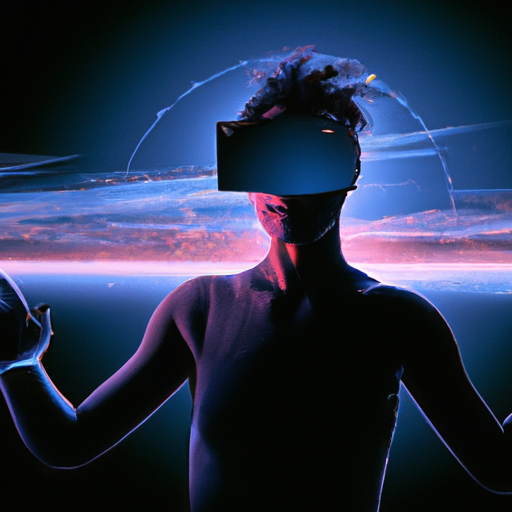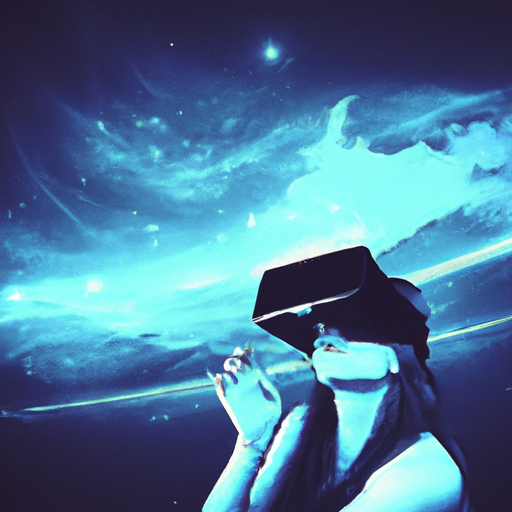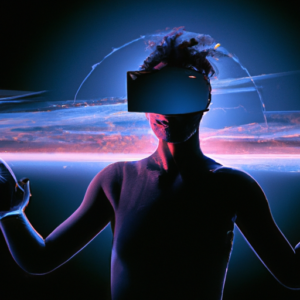In this article, we’ll be exploring the exciting possibilities that lie ahead for virtual reality technology. You’ll learn about the current advancements in VR, how it’s being utilized in different industries, and what experts predict for its future growth. We’ll also dive into the potential challenges and ethical considerations that may arise as virtual reality becomes more prevalent in our lives. So, let’s take a look into the crystal ball and see what the future holds for VR!

Introduction
Virtual reality (VR) technology has rapidly gained popularity in recent years, providing users with immersive experiences that transport them to virtual worlds. This article will explore the advancements, potential industries impacted, challenges, future trends, ethical implications, emerging technologies, investment and funding, and regulatory considerations surrounding VR technology.
Understanding virtual reality technology
Virtual reality technology creates a simulated environment that can be similar to or completely different from the real world. It usually involves the use of headsets with built-in displays that track head movements, providing users with a 360-degree view of their virtual surroundings. VR also often includes motion tracking controllers to enhance the interactive experience.
Current applications of virtual reality
Virtual reality is already being used in various industries and has proven its potential for enhancing user experiences. Some notable current applications of VR technology include:
Gaming and entertainment
Virtual reality gaming takes the gaming experience to a whole new level by allowing players to fully immerse themselves in virtual worlds. With VR, players can explore fantasy realms, compete in realistic sports simulations, or even experience adrenaline-pumping adventures from the comfort of their living rooms.
Education and training
VR technology has shown immense promise in education and training. It enables students to visit historical sites, explore distant planets, or practice complex procedures in a safe and controlled virtual environment. VR has the potential to revolutionize education by making learning more engaging, interactive, and accessible to students of all ages.
Healthcare and therapy
Virtual reality has proven to be a valuable tool in the healthcare industry. It allows medical professionals to simulate surgeries, train doctors on complex procedures, and create realistic environments for physical and mental therapy. VR therapy has shown promising results in treating conditions like phobias, PTSD, and anxiety disorders.
Architecture and design
Architects and designers are utilizing VR technology to visualize and experience architectural designs before construction begins. VR allows clients to virtually walk through their future homes or offices, giving them a better understanding of the final product. This immersive experience helps architects and designers make more informed decisions and enables clients to provide valuable feedback.
Advancements in virtual reality technology
Virtual reality technology continues to evolve and improve, bringing several advancements that enhance the overall user experience. Some notable advancements include:
Improved resolution and visual quality
Early VR headsets suffered from low resolution and pixelation, causing a noticeable screen-door effect. However, newer VR headsets have significantly improved resolution and visual quality, providing users with more realistic and immersive experiences. Higher resolution displays and advancements in optics have contributed to a clearer and more detailed visual experience.
Enhanced tracking and motion sensing
Accurate tracking and motion sensing are crucial for a seamless VR experience. Advances in tracking technology, such as inside-out tracking, have eliminated the need for external sensors, making VR more accessible and user-friendly. Additionally, improved motion sensing allows users to interact with virtual objects more intuitively, further enhancing the immersive experience.
Development of wireless and standalone VR devices
Early VR systems required powerful PCs and extensive cables, limiting mobility and convenience. However, recent developments have seen the rise of wireless and standalone VR devices, eliminating the need for a PC or tethered connections. These standalone devices offer a more streamlined user experience, making VR more accessible to a wider audience.

Potential industries impacted by virtual reality
Virtual reality has the potential to impact various industries beyond gaming and entertainment. Some potential industries that could see significant transformations due to the integration of VR technology include:
Gaming and entertainment
While VR is already making waves in the gaming industry, there is still immense potential for growth and innovation. As technology advances, game developers can create more immersive and realistic experiences, pushing the boundaries of what is currently possible in gaming.
Education and training
VR has the power to revolutionize education and training across various fields. Virtual classrooms could become the norm, allowing students to interact with teachers and peers from all over the world. Training simulations in industries such as aviation, military, and emergency response could also become more realistic and effective, leading to better-prepared professionals.
Healthcare and therapy
As VR becomes more advanced and accessible, its potential in healthcare and therapy continues to expand. Virtual reality can be used to train medical professionals, provide remote healthcare services, and even assist in pain management. By immersing patients in relaxing or distracting virtual environments, VR has the potential to alleviate discomfort and anxiety during medical procedures.
Architecture and design
Virtual reality is already transforming the architecture and design industries, but the possibilities are endless. VR can aid in the creation of more accurate and functional designs, allowing architects and designers to visualize projects before they are built. Clients can also experience and provide feedback on designs in a more immersive and comprehensive way.
Challenges and obstacles in the adoption of VR
Despite its potential, virtual reality technology still faces several challenges and obstacles that hinder its widespread adoption. Some of the key challenges include:
Cost and accessibility
The cost of VR headsets and equipment can be a barrier for many consumers. High-quality VR headsets often come with a hefty price tag, making them inaccessible to a significant portion of the population. Additionally, the requirement of a powerful PC for some VR systems further adds to the overall cost, limiting the accessibility of VR technology.
User discomfort and motion sickness
Virtual reality can cause discomfort and motion sickness in some users, especially during extended use. Symptoms can include dizziness, nausea, and eyestrain. While advancements have been made to reduce these issues, minimizing user discomfort remains a challenge that VR developers need to address to ensure a comfortable and enjoyable experience for all users.
Limited content and experiences
Another challenge for VR is the limited amount of content and experiences currently available. While gaming has seen considerable growth, other industries are still in the early stages of exploring the potential of VR. More diverse and compelling content is needed to attract a wider audience and encourage the adoption of virtual reality technology.
Future trends in virtual reality
Virtual reality technology is poised for continued growth and innovation. Several exciting trends are likely to shape the future of VR, including:
Integration with augmented reality
The integration of virtual reality with augmented reality (AR) has the potential to create a more immersive and interactive experience. Combining virtual and real-world elements can enhance the way we interact with digital content and bridge the gap between the physical and virtual worlds.
Social and collaborative VR experiences
As VR becomes more accessible, the demand for social and collaborative experiences is expected to increase. Virtual meetups, multiplayer games, and interactive virtual environments that allow users to interact and socialize with others are likely to gain popularity. This trend could significantly impact how we connect and communicate with each other.
Expanded use in online shopping and marketing
Virtual reality has the potential to revolutionize the way we shop and market products online. With virtual showrooms and immersive product experiences, customers can have a more interactive and engaging shopping experience. Virtual try-ons and the ability to visualize products in real-world settings can redefine online shopping, making it more personalized and enjoyable.
Potential ethical and societal implications of VR
While virtual reality holds immense potential, it also raises ethical and societal concerns that need to be addressed. Some potential implications include:
Impact on human interaction and relationships
As VR technology advances, there is a risk of it disconnecting people from the real world. Spending extended periods in virtual environments could potentially impact real-world relationships and interactions. Striking a balance between virtual and real-world experiences is crucial to maintain healthy social connections.
Privacy concerns and data security
Virtual reality often requires the collection and storage of personal data to provide personalized experiences. This raises concerns about privacy and data security. Strict regulations and protocols need to be in place to protect users’ personal information and ensure that data is used ethically and responsibly.
Virtual addiction and escapism
Virtual reality has the potential to be highly immersive and addictive. Spending excessive amounts of time in virtual worlds could lead to escapism and detachment from real-life responsibilities. Education and awareness about responsible VR usage are essential to prevent potential addiction and mental health issues.
Emerging VR technologies to watch out for
The future of virtual reality is filled with exciting technological advancements that have the potential to further enhance the immersive experience. Some emerging VR technologies to watch out for include:
Eye tracking and foveated rendering
Eye tracking allows VR headsets to accurately track users’ eye movements, enabling more realistic and immersive experiences. Foveated rendering, a technique that dynamically adjusts the image quality based on eye movement, can significantly improve performance and visual realism.
Haptic feedback and sensory immersion
Haptic feedback technology offers users a sense of touch, allowing them to feel virtual objects and textures. By incorporating haptic feedback into VR experiences, users can have a more immersive and realistic interaction with the virtual environment. Combined with other sensory immersion technologies, such as smell and temperature simulation, VR can stimulate multiple senses, further enhancing the overall experience.
Brain-computer interfaces
The development of brain-computer interfaces (BCIs) has the potential to revolutionize the way we interact with virtual environments. BCIs can translate brain signals into commands, allowing users to control VR experiences purely with their thoughts. This technology could open up new possibilities for individuals with limited mobility and provide more intuitive interactions in VR.
Investment and funding in VR technology
The growth of virtual reality technology has attracted significant investment and funding from various sources. Some notable aspects of investment and funding in VR include:
Venture capital and startup ecosystem
Venture capital firms have been actively investing in VR startups, recognizing the potential for growth and innovation in the industry. VR-focused accelerators and incubators have also emerged, providing entrepreneurs with the necessary resources and support to bring their innovative VR ideas to market.
Corporate partnerships and acquisitions
Major corporations are investing in VR technology and forming partnerships with startups to harness its potential. Technology giants like Facebook, Google, and Microsoft have made substantial investments in VR, either through acquisitions or by developing their own VR hardware and software solutions. These partnerships and acquisitions contribute to the advancement and expansion of VR technology.
Regulatory considerations for virtual reality
As virtual reality technology becomes more prevalent, regulatory considerations become increasingly important. Some key considerations include:
Health and safety regulations
Due to the potential health effects of extended VR use, governments and regulatory bodies may implement health and safety regulations. These regulations may involve guidelines for safe VR usage, including recommended usage time, ergonomic considerations, and warnings about potential side effects.
Content moderation and censorship
Virtual reality content poses unique challenges for content moderation and censorship. As VR experiences become more immersive and realistic, regulations may be put in place to ensure that VR content adheres to ethical and legal standards. Striking a balance between creative freedom and responsible content creation will be crucial in shaping VR regulations.
Conclusion
Virtual reality technology is continually evolving, offering new possibilities and advancements. As resolution and visual quality improve, tracking and motion sensing become more accurate, and wireless and standalone VR devices eliminate barriers to access, the future of virtual reality looks promising. With potential impacts on industries such as gaming, education, healthcare, and architecture, VR has the power to transform the way we learn, work, and entertain ourselves.
However, challenges such as cost and accessibility, user discomfort and motion sickness, and limited content still need to be addressed for wider adoption. By integrating with augmented reality, enabling social and collaborative experiences, and expanding its use in online shopping and marketing, VR can continue to grow and evolve.
Ethical and societal implications, such as the impact on human interaction and relationships, privacy concerns, and virtual addiction, need to be carefully considered and regulated. Exciting emerging technologies like eye tracking and foveated rendering, haptic feedback and sensory immersion, and brain-computer interfaces have the potential to further enhance the immersive VR experience.
Investment and funding from venture capital firms and corporate partnerships are driving the growth and innovation in the VR industry. Regulatory considerations, including health and safety regulations and content moderation, will also play a vital role in shaping the future of virtual reality.
In conclusion, the future of virtual reality technology holds immense promise. With continued advancements, increased accessibility, and responsible regulation, VR has the potential to reshape industries, improve user experiences, and enhance how we connect and interact with the digital world.
